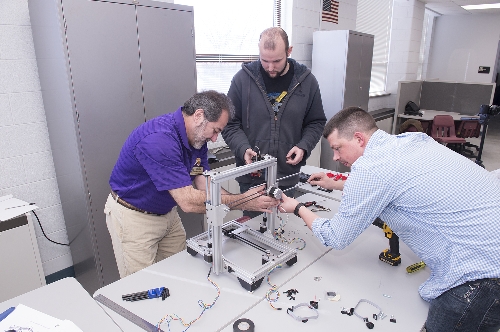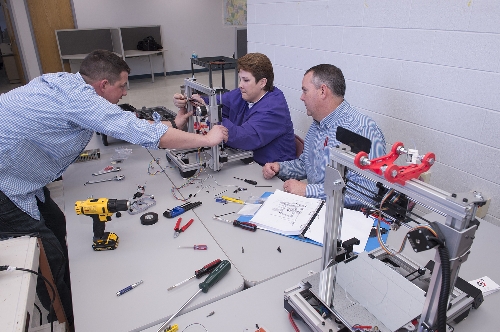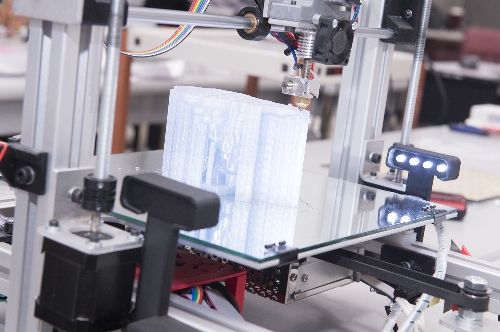University News
WIU Professor Giving Students Hands-on, Real-world Opportunities While Bringing Upgraded Technology to Campus
October 2, 2015
MACOMB, IL – Western Illinois University Engineering Technology (ET) Professor Rafael Obregon is putting the University's technology in the hands of his students. He and a team of several faculty members, undergraduate and graduate students built two 3-D printers from scratch, which the College of Business and Technology (CBT) departments can now use for various hands-on learning projects.
Obregon explained that 3-D printing is part of a larger concept, additive manufacturing, which means to stack materials to create a shape with layers.
The technology of 3-D printing is a process of using a machine that can make a three-dimensional object without using a mold or mass-manufacturing machines. The objects can virtually be any shape or geometry and are produced by entering a code or data into a computer connected to the printer, which, depending on the size of the printer, can print small objects or very large objects. The machine creates the objects by layering a particular material.
"Imagine you have a hot glue gun and a glue stick, which is solid to a certain extent," explained Obregon. "If we heat that glue and instantly melt it, it will allow us to create a line of melted material, which is soft for a period of time. If we create a circle and let it harden, then put another layer on top of that and let that harden and repeat the process 100 times, we will end up with a cylinder."
However, according to Obregon, while this technology is somewhat new to Western, it is not new to the business world.
The idea of rapid prototyping, additive manufacturing and 3-D printing started in the mid-1980s. Two different companies developed two methods for printing three-dimensional objects, 3-D Systems Corp. and Stratasys. The first company, 3-D Systems, used the laser sintering method, while Stratasys used the method applied by the printers Western houses—fusing the material, layer by layer. Both quickly patented their products, making it expensive to use the technology for 25 years, until the patents expired and the technology was open for companies to replicate, therefore, making it much less expensive to utilize.
"This technology is not new by any means, but access to it is," Obregon said. "Thirty years ago, it would have cost $125,000 to acquire a very small 3-D printer and probably about $1 million for one capable of making something about three cubic feet. For a state university, that would be completely out of reach. Then, after the technology became more available, there was an explosion of companies making 3-D printers, which brought down the price. Several organizations started putting the recipe for making your own out there. In fact, that's kind of where we got the idea of building our own."
Staff in the Center for Innovation in Teaching and Research (CITR) acquired Western's first 3-D printer in 2013 with the purchase of a Makerbot Replicator 2X (see wiu.edu/news/newsrelease.php?release_id=10956). The printer is available to WIU faculty and staff for research and classroom projects and can create objects up to the size of a small loaf of bread. CITR has purchased a second Makerbot since and has two available.
In 2013, the Engineering Technology Department purchased the CBT's first 3-D printer, also a Makerbot, which according to Obregon, was the first brand that started exploring producing 3-D printers and selling them at a more cost-effective rate for consumers.
Obregon explained that while the printers are available at a more reasonable price now, they are still not necessarily easily worked into a budget of a state university. He began to research how the machines are made, and he created a few programs that manipulate the information generated by the CAD (computer-aided design) software, the part of the 3-D printing process in which the information input by a human is translated in the computer to a language the 3-D printers understand. He was a presenter for the 69th Midyear ASEE (American Society for Engineering Education) conference in Bloomington (IL) during Fall 2014, where he showed his findings regarding the programs. While he was there, a businessman from Bloomington (IL) spoke following Obregon about how he teaches people to make their own 3-D printers.
After the presentations, he and Obregon were able sit down and discuss how they might be able to collaborate. Obregon shared information on reducing input information to make his process more efficient, and the businessman shared information on creating a 3-D printer from scratch for less than $1,000.
Following the initial collaboration with the businessman, Obregon returned to Western with new knowledge and excitement about WIU's Engineering Technology Department faculty and students producing their own printers. In March, he again collaborated with numerous CBT departments, faculty, students and staff to produce two new printers. Through a three-day workshop, students and faculty from various departments came together to build the new printers.
"About 25 percent of each machine consists of 3-D printed parts—it took about 16 hours to print all of the parts. About 25 percent is made up of commercial products that wouldn't be practical to try to create, like electrical circuits that control the motion of the machine and the controller board that tells the machine to move this and heat that, along with ball bearings, nuts, cables, etc.," Obregon explained. "The other 50 percent are pieces that could be produced in-house at Western. Our machine and manufacturing guys can do the metal pieces; our electronic guys can flash the control of the machine, which includes software that tells the machine the size of the platform, how much the motors can travel and what temperature to use to heat the different elements. The aluminum pieces that hold together different elements can be made in our machine shop."
The first workshop day, Obregon invited faculty to participate. The second day, mostly graduate and undergraduate students were present.
"I was part of the workshop," said Obregon. "I was learning. I had the opportunity to see how my students were going through this.
"The best thing that will hopefully come out of this project is what it can do for our curriculum," he added. "In my design or production classes, I have my students do some sort of a team project. This opens the door to a multidisciplinary teamwork project. Ideally, I would like to see this turned into a capstone project."
Obregon explained that Western offers a series of classes related to design, and this type of hands-on learning is a great educational tool.
During the Spring 2014 semester, two engineering technology students were able to use the hands-on tool to make business connections and take home first place at a national conference. Scottie Waldhaus, from Quincy (IL), and Darren Walker, of Fort Madison (IA), presented their winning design at the Direct Digital Manufacturing (DDM) Design Competition. As the first place team, they were able to present their design—which they created using the ET department's 3-D printer—during the DDM Tech Group meeting and have their design distributed by show-floor exhibitors as pieces for the conference. They also received a complimentary pass to RAPID 2014, the industry-leading forum for discussion of the latest developments, trends and techniques specific to additive manufacturing, rapid technologies and 3-D printing and scanning. (Read more about it at wiu.edu/news/newsrelease.php?release_id=11771.)
"The fact that two of our students won the competition is huge," said Obregon. "It is the largest exposition of its kind in the world, and it shows that Western and our students are very in tune with what's happening outside of this area.
"These printers have given me new ways to encourage my students to have an understanding of three-dimensional perception," he added. "I can just tell my students to create a model; however, if once they create it, I bring them to the printer and tell them to actually produce it in 3-D, there are so many things that start clicking in their brain as they are making all of the connections. It's a great real-world application process."
For more information about the WIU Engineering Technology department, visit wiu.edu/engrtech or call (309) 298-1091.
Posted By: Alisha Looney (AA-Looney@wiu.edu)
Office of University Communications & Marketing




Connect with us: